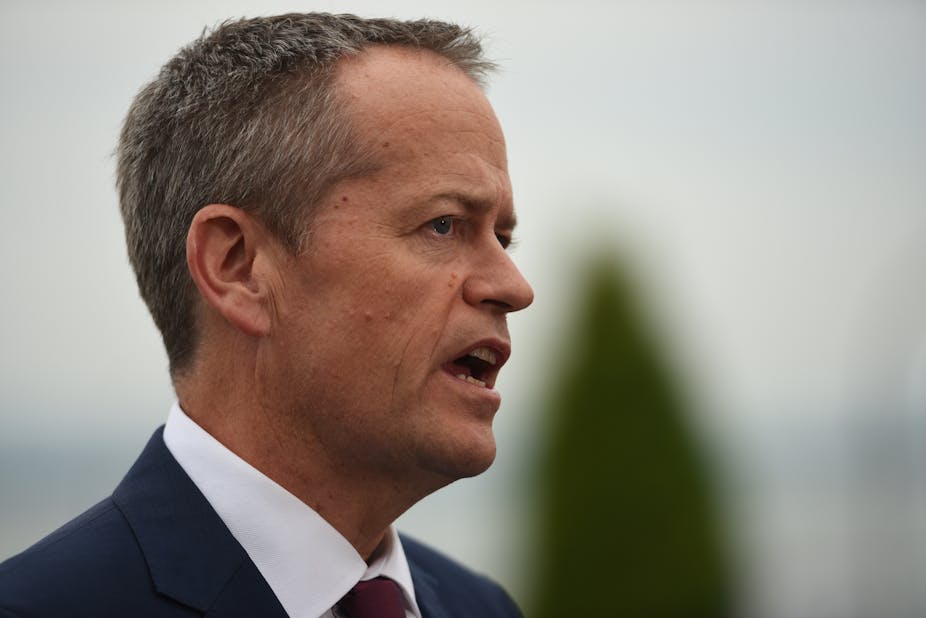Following Roman general Marc Antony’s lead, and aggrieved by a defiant and vexatious Senate, Malcolm Turnbull on the weekend finally cried havoc and let slip the dogs of war.
Of course, the “havoc” in this case is the double-dissolution election and the “dogs of war” are political advertisers.
Both Labor and the Liberals released television advertisements nearly as soon as Turnbull called the election. They are based on familiar talking points. But it is telling that both major parties focused their first ads on Labor leader Bill Shorten.
The presentation of Shorten
Comedian Shaun Micallef has made famous Shorten’s one-liners, or “zingers”. These highlight the rhetorical awkwardness of the would-be prime minister.
So, Labor is determined to show Shorten as decisive. With little to lose but a lot to gain, it has recognised that presenting its leader in a positive light, with a suite of policy ideas to back him, is critical to securing victory on July 2.
In stark contrast, the Coalition has borrowed from former George W. Bush adviser Karl Rove’s playbook and sought to portray Shorten as a “flip-flopper”. Its first salvo pits Shorten against Shorten, quoting him one year then juxtaposing his shifting positions to a soundtrack of frivolous music.
Such music, as a classic cinematic ploy, suggests a frivolous personage. It’s a powerful theme; the prevailing view of the ideal leader is decisiveness and prescience.
In 2004, the Bush team portrayed Democratic presidential nominee John Kerry as lacking leadership, and as someone whose ideas went “whichever way the wind blows”. Its ad, which showed Kerry constantly changing tack while windsurfing, was powerfully effective: Kerry looked silly, “unpresidential”.
This was juxtaposed with a shot of Bush, standing on his balcony with his wife Laura, saying:
I approve this message.
The contrast couldn’t have been stronger. Kerry was indecisive and aloof, Bush was a family-values man of action. All in 30 seconds.
The Coalition’s attack ads borrow this theme. But the sophistication of its ad is lacking. While it does show Shorten contradicting himself, there is a danger that the viewer will like his new position.
The ad’s most powerful part was the shot of Shorten dancing. Images matter. And in determining leadership qualities, voters aren’t very forgiving of those who like hitting the dancefloor.
By contrast, Turnbull, despite his falling popularity, maintains an air of superiority. Who can forget the many rebellious, leather-jacketed media appearances he made while in the leadership wings? He had carefully cast, then, an image as an intellectual outsider. Changing an entrenched public view is difficult to do in eight weeks.
The advertisements will play to these personality differences. The Coalition’s ammunition has Shorten’s name engraved on it. Equally, Labor is keen to recast Shorten as decisive and the candidate of positivity and hope.
But both parties will attack each other relentlessly. The efficacy of attack ads is too great to ignore as a political tool. The mud sticks.
Rationally, this makes negative ads unavoidable. Playing “nice” and remaining above the fray gives your opponent a free kick that you may not recover from.
What to expect in the 2016 campaign
It’s pretty clear what form ads will take in this campaign. Guilt-by-association politics will play a big role: Labor’s relationship with the unions; the Liberals’ perceived affiliation with big business, especially the banks.
Labor will play to its traditional strengths: health care, education and the anomalous category of “fairness” – a word we will hear ad nauseam.
The Coalition’s key talking points are building a strong economy and its assertion that it has “stopped the boats”.
But it’s telling that the words “debt” and “deficit” have curiously disappeared from the Coalition lexicon. At the last election, they were uttered with the frequency of conjunctions. Now the words have become liabilities.
It may even be tempting for Labor to start using them. It’s a risk, but one potentially mitigated by the circumstances in which Labor took on debt in government – that is, the global financial crisis.
Who voters would favour on the issue is unknown. Neither party seems prepared to risk it, but the explosion of debt under the Coalition, especially given the importance it placed on it only three years ago, may well serve Labor’s interests.
Beyond the economy, however, are the divisive wedge issues. As immigration tensions flare abroad, and the spectre of gang violence becomes increasingly linked to refugees, the Howard-era mantra, “we will decide who comes to this country” will return. Already, the Coalition is suggesting that Labor is poised to flip-flop on the issue.
Again, the Coalition’s attack is focused more on Shorten than his party. Not since Kevin ’07 has a campaign been so tied to the respective party leaders. On this count, Turnbull has a near-unassailable lead. But budgetary weaknesses and the issues of tax and “fairness” are there for Labor to exploit.
No wonder, then, that the polls suggest this election is on a knife-edge.

